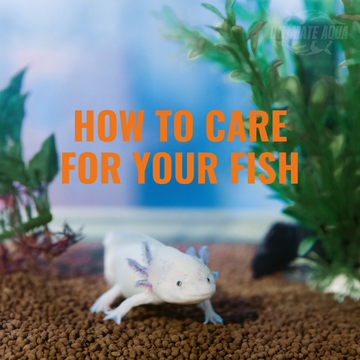Welcome to the beginner's guide on how to care for your fish. If you're new to the world of aquariums and fishkeeping, you're in the right place. In this comprehensive guide, we'll walk you through the essential steps to ensure the health and happiness of your aquatic pets. Whether you've just acquired your first fish or are looking to improve your existing setup, you'll find valuable insights here. Let's dive in and explore the fascinating world of fish care.

1. Setting Up Your Aquarium
Before you bring home your finned friends, it's crucial to create a suitable habitat for them. This section will cover:
- Choose the right tank size and location
When it comes to setting up your aquarium for optimal fish care, there are several key considerations to keep in mind. The first step is selecting the right tank size and location. It's essential to choose a tank that suits both your living space and the specific fish species you plan to keep. Larger tanks generally provide more stable water conditions, which is crucial for fish health. Ensure that the tank's location receives adequate light but avoids direct sunlight to prevent excessive algae growth.
- Select appropriate filtration systems
Proper filtration is the heart of any healthy aquarium. A quality filter helps remove harmful substances like ammonia and nitrite, ensuring your fish enjoy clean and oxygenated water. There are various types of filters, including mechanical, biological, and chemical filters, each with its benefits.
- Add decorations and substrate to create a natural environment
To create a natural and aesthetically pleasing environment for your fish, consider adding decorations and substrate to your tank. Fish feel more at ease in an aquarium that mimics their natural habitat. Choose substrates and decorations that are fish-safe and non-toxic. Make sure to create hiding spots and swim-throughs for your fish to explore, promoting their physical and mental well-being.
2. Selecting the Right Fish Species
Selecting the right fish species is a critical aspect of fish care. Different fish have varying care requirements, temperaments, and compatibility levels. So it's essential to choose species that are compatible with your experience level and tank conditions. We'll discuss:
- Beginner-friendly fish species
For beginners, it's wise to start with hardy and beginner-friendly fish species like guppies, bettas, or goldfish. These fish tend to be more forgiving of minor mistakes and are easier to care for.
- Compatibility among different fish
Compatibility among different fish species is essential to maintain a peaceful and stress-free aquarium environment. Some fish are territorial or aggressive, while others are peaceful community fish. Research the behaviors and compatibility of the species you plan to keep, and avoid mixing species that may exhibit aggressive tendencies or have significantly different care needs.
- Tips for acquiring healthy fish
To make informed choices about your fish, it's crucial to research each species thoroughly. Consider factors such as water temperature, pH levels, tank size, and dietary preferences. Consult reputable sources and seek advice from experienced aquarists or your local fish store to ensure you make the right choices for your specific aquarium setup.

3. Water Quality and Maintenance
Maintaining optimal water quality is fundamental to fish care. You should learn how to:
- Monitor water parameters (pH, ammonia, nitrite, nitrate)
Checking water parameters such as pH, ammonia, nitrite, and nitrate levels is vital. Fluctuations in these parameters can stress or harm your fish. Use test kits to regularly check these values and take corrective actions when needed.
- Perform regular water changes
Regular water changes is a key component of water quality management. Aim for weekly or bi-weekly water changes, removing about 10-25% of the aquarium water and replacing it with dechlorinated, temperature-matched fresh water. This helps dilute harmful substances and replenishes essential minerals and trace elements.
- Clean and maintain your aquarium equipment
Cleaning and maintaining your aquarium equipment is another essential aspect of fish care. Regularly clean the filter media and remove debris from the tank's substrate. Ensure that your filter is running optimally, as it plays a significant role in water quality. Also, check the condition of your heater, air pump, and any other equipment to prevent malfunctions that could harm your fish.
- Recognize and address common water quality issues
Recognizing and addressing common water quality issues is crucial to prevent fish health problems. Keep an eye out for signs of stress, disease, or abnormal behavior in your fish. Rapid response to issues like cloudy water, algae blooms, or temperature fluctuations can make a significant difference in maintaining a healthy aquarium.

4. Feeding and Nutrition
Proper nutrition is crucial for the health of your fish. In this section, we'll explore:
- Understanding the dietary needs of different fish species and choosing high-quality fish food
Different fish species have varied dietary requirements, so it's essential to understand what your specific fish needs. High-quality fish food is essential to provide essential nutrients and vitamins for optimal health.
Avoid the temptation to offer your fish human food, as many human foods can be harmful or even toxic to fish. Stick to specially formulated fish food to ensure they receive the proper nutrition.
- Establishing a feeding schedule
Establishing a feeding schedule is vital to prevent overfeeding, which can lead to water quality issues. Feed your fish a measured amount of food once or twice a day, depending on their species and size. Remove any uneaten food after a few minutes to avoid polluting the water.
- Avoiding overfeeding and its consequences
Overfeeding can lead to excess nutrients in the tank, which may cause problems like algae growth and water quality deterioration. It's essential to strike a balance between providing enough food for your fish to thrive and avoiding overfeeding.

5. Health and Disease Management
Even with the best care, fish can sometimes fall ill.
- Recognize common fish diseases and symptoms
Recognizing common fish diseases and their symptoms is crucial for prompt treatment. Keep an eye out for signs such as changes in behavior, fin damage, unusual growths, or changes in coloration.
- Isolate and treat sick fish
Isolating and treating sick fish is essential to prevent the spread of disease to other tank inhabitants. Set up a quarantine tank to separate the sick fish and treat them with appropriate medications or treatments. Quarantine also allows you to monitor the fish closely and prevent any further stress from tankmates.
- Prevent disease through quarantine and hygiene
Prevention is often the best strategy in fish health. By quarantining new fish before adding them to your main aquarium and maintaining excellent water quality, you can minimize the risk of disease outbreaks. Regularly clean and disinfect aquarium equipment, and avoid introducing items from unknown or potentially contaminated sources.
- Seek advice from experts and professionals
Seeking advice from experts and professionals is always a good practice. If you're unsure about a fish's condition or need guidance on treatment, consult with your local aquarium store or reach out to experienced aquarists in online forums or fishkeeping communities. Knowledge and early intervention can make a significant difference in your fish's health and well-being.

Conclusion:
In conclusion, fish care is a multifaceted endeavor that requires careful consideration of your aquarium setup, fish selection, water quality, feeding, and disease management. By following the guidelines outlined in this beginner's guide, you'll be well-equipped to provide a safe and thriving environment for your aquatic companions.

